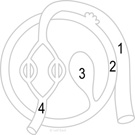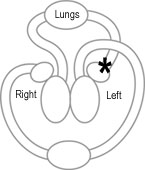IPHY 3410
Instructor: Dr. Leif Saul
Fall 2023

IPHY 3410Instructor: Dr. Leif Saul
|
 |
Some of the practice questions already provided for the first, second, and third exams are applicable (in some cases with slight modification) to the old material you need to know for the Final Exam, so a number of them are also included here (with modification if necessary) for your convenience. NOTE: On the Final Exam, questions from new and old material will be mixed together in random order.
1. Cilia occur in or on:
A. epithelium of upper respiratory tract
B. epithelium of kidney tubules
C. goblet cells
D. A and B
E. A and C
2. The alveoli (surface responsible for gas exchange) in the lungs are lined with _____________ epithelium.
A. stratified squamous
B. simple squamous
C. simple columnar
D. pseudostratified columnar
E. transitional
3. The type of membrane that covers the outside (superficial) surface of the digestive organs is called the:
A. mucous membrane.
B. serous membrane.
C. glandular membrane.
D. squamous membrane.
E. secretory memrane.
4. Adipose tissue is a major component of:
A. epidermis
B. dermis
C. hypodermis
D. pancreas
E. ligaments
5. You are shrunk down to microscopic size, magically transported into the body of your roommate, and find that your feet are standing on the surface of a mesothelium, and you are in a body cavity surrounded by fluid. The fluid is:
A. The interstitial fluid of an areolar connective tissue.
B. The mucus lining on the mucosa of a hollow organ.
C. Serous fluid, which is produced mainly by secretion.
D. A filtrate of blood.
E. Blood plasma.
6. In the idealized diagram of body cavities and membranes that was presented in class, which of the following lists layers and/or spaces in correct order, from superficial to deep?
A. Visceral serosa, parietal serosa, mucosa
B. Cutaneous membrane, mucous membrane, visceral serosa
C. Parietal serosa, lumen, visceral serosa
D. Mucous membrane, parietal serosa, cutaneous membrane
E. Serous cavity, visceral serosa, mucosa
7. Retroperitoneal organs such as the pancreas
A. Are suspended by mesenteries
B. Have adventitia
C. Have peritoneum
D. B and C
E. All of the above
8. The sword pierced Octavius' belly, and the point of the sword ended up just reaching an olive in his stomach. Numerous layers of his body tissues and internal spaces were pierced in the process. Each of the following lists only some of these. Which of the following gives the layers or spaces in the correct order (from superficial to deep)?
A. Visceral peritoneum, peritoneal cavity, mesothelium
B. Lamina propria, mesothelium, lumen
C. Peritoneal cavity, visceral peritoneum, parietal peritoneum
D. Mesothelium, epithelium of mucosa, lumen
E. Peritoneal cavity, parietal peritoneum, lumen
9. Which of the following represents a possible path that blood may follow as it moves ONCE through the systemic circuit? (Some steps may be omitted.)
(1) Heart, (2) Capillaries, (3) Arteries, (4) Veins
A. 3 --> 4 --> 2 --> 4 --> 1
B. 1 --> 3 --> 4 --> 2 --> 3
C. 3 --> 2 --> 3 --> 2 --> 4
D. 1 --> 4 --> 2 --> 3 --> 1
E. 2 --> 3 --> 2 --> 4 --> 1
10. Internal respiration occurs
A. In the muscle tissue forming most of the wall of the heart
B. In the systemic circuit
C. In the pulmonary circuit
D. A and B
E. All of the above
11. The pulmonary trunk
A. Is a vein carrying deoxygenated blood
B. Is an artery carrying deoxygenated blood
C. Is a vein carrying oxygenated blood
D. Is an artery carrying oxygenated blood
E. Alternates between carrying oxygenated and deoxygenated blood
12. Blood flows through the mitral valve into the
A. Aorta
B. Pulmonary trunk
C. Right ventricle
D. Left ventricle
E. Right atrium
13. The second sound (the "dup" in "lub-dup") of each heart beat results when
A. The squeezing down of the ventricles pushes blood against the walls of the heart
B. Blood rushes into the ventricles to fill the vacuum produced after contraction
C. The large arteries connected to the heart recoil, causing valves to close
D. The chordae tendineae are suddenly pulled tight by the closing valves
E. Blood rushing out through the arteries vibrates the artery walls
14. REMOVED
15. A nerve fiber
A. Is connective tissue at the core of every nerve
B. Is also known as a neuron
C. Is a group of blood vessels accompanying a fascicle
D. Is found only in some nerves
E. None of the above
16. Lymphatic capillaries
A. Have a wall consisting of endothelium only
B. Have minivalves
C. Carry fluid in one direction only
D. B and C
E. A, B, and C
17. Oxygen diffuses from blood into a muscle cell. This process is known as
A. Internal respiration
B. External respiration
C. Cellular respiration
D. Ventilation
E. Inspiration
18. Which of the following is an example where elastic connective tissue is a major component?
A. Fibrous capsules of organs and joints
B. Artery walls
C. Lymphoid organs
D. Fascia
E. Dermis
19. In the diagram at right, region 2 contains ___ which flows directly into region ___. |
 |
20. In the diagram in question 19, the fluid leaving region 4 will first enter what chamber of the heart?
A. Left atrium
B. Left ventricle
C. Right atrium
D. Right ventricle
E. [Not an option]
21. In the diagram at right, what heart valve is indicated by the asterisk? |
 |
22. In the diagram in Question 21, blood flows directly from the ___ to the asterisk.
A. Left atrium
B. Pulmonary veins
C. Pulmonary arteries
D. Pulmonary trunk
E. Superior vena cava
ANSWERS
1 A
2 B
3 B
4 C
5 D
6 E
7 D
8 D
9 A
10 D
11 B
12 D
13 C
14 REMOVED
15 E
16 E
17 A
18 B
19 C
20 C
21 E
22 B